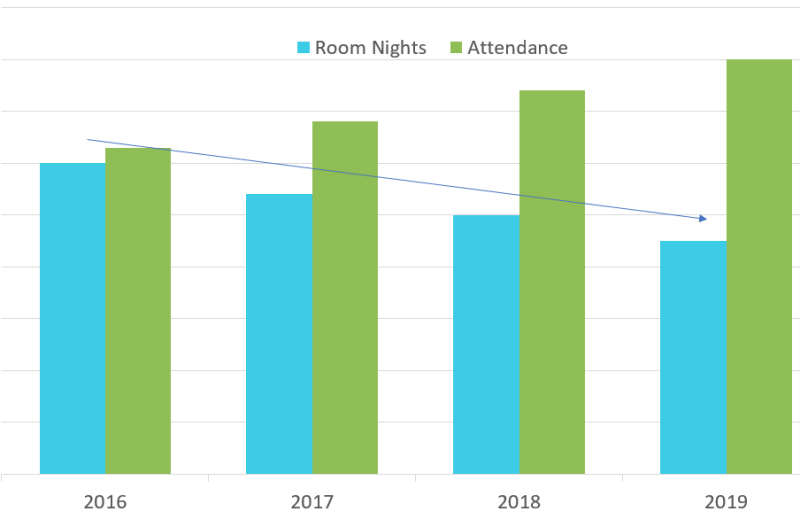In our 2Synergize consulting practice, we focus on helping destinations gain a competitive edge in the meetings and events market. We understand the complexities of your roles and the importance of rightly communicating your value with your meeting planners, hoteliers, convention center partners and many other stakeholders. The ability to convey exemplary sales efforts is often dependent upon using the appropriate performance metrics with each of your audiences.
According to 2Synergize’s most recent DMO Booking Practices Study, room nights continue to be the predominant metric for sales production and contribution to the community. Yet, many DMOs are wondering if the sole focus on room nights accurately reflects their sales efforts and if this post-pandemic environment provides the perfect opportunity to look at additional metrics which more fully bear their value.
Enter our most recent webinar, Are You Ready to Move Away from a Sole Focus on Room Nights? I was joined by my industry friends and colleagues Junior Tauvaa, Chief Sales Officer, Visit Anaheim, and Scott Beck, President & CEO, Destination Toronto. Both are passionate industry advocates for DMO sales metrics – not excluding room nights, but as Scott suggested, “inclusive of all metrics that represent an event’s impact to the destination.” Junior rightly coined the phrase, “We need more than one gas pedal!”
Before We Start, a Few Distinctions to Make
Nomenclature: First, we would be wise to consider our language and naming conventions. Many of the terms we use to describe event impact can be both simplified and chosen independently considering the audience. Scott suggested the impact of COVID has given us an unprecedented opportunity to redefine our nomenclature as we speak to the quantification of an event’s impact, elevating the attendee and their total economic impact in the destination beyond the guest room they use during their stay.
Differentiation: It is important to first reflect on how you use definite room nights. Are room nights a measure for the convention’s true impact on the destination, a sales production measure, or a key performance indicator (KPI) to help you with strategic booking decisions? It is important to make the distinction, as confusing the two further muddies the water as we speak of overall value.
Citywide or Hotel Meetings: In discussing the event impact metrics, many similarities can be drawn between citywide and single hotel events, but we have focused this discussion primarily around citywide impact, allowing for the concepts to be applied to single property events where appropriate.
With that out of the way, let’s jump right in and give you a recap of the discussion addressing three primary questions:
- What is the problem with using definite room nights as the predominant performance metric?
- If not definite room nights, then what are the recommendations for other performance metrics?
- How do we engage our stakeholders to buy into considering additional metrics?
The Problem with Room Nights
Room nights alone are problematic, yet we continue to define our value and use them as the predominant organizational-wide measurement of our contribution. We use room nights in our contracts with our funding agency, our measure for sales production, and financial incentives to events, not to mention for paying out sales managers incentives.
So, what is the problem with room nights? Well, they are just room nights. As Scott so articulately stated in our webinar, “Room nights don’t generate economic impact. Attendees do.”
Room nights alone do not validate the event's impact on the destination. Those attendees do far more than sleep. They shop, eat, drink, and support employment and tax generation in our cities. And even attendees who don’t stay overnight make an economic contribution.
Technology has forever changed the way people book travel in that nearly one out of every two meeting attendees book their accommodations outside the event organizers’ room block. Because of this, it’s almost impossible to track all the room nights associated with an event adequately.
Even hotels have expanded their primary metrics to include the food and beverage and rental revenue contribution of an event. Clearly, we should continue to measure the room night, but it should no longer define our value and hold its place as our top and often sole measurement industry-wide.
Alternative Metrics to Consider
There are multiple equations to consider, and no one metric will encompass the totality of group impact for every event in every destination. As well, there is not an all-encompassing metric that will be appropriate for all audiences. The secret sauce is found in combining multiple metrics that define impact and in adjusting the use and presentation of your metrics to best resonate with different stakeholders.
- Attendance, along with the demographics of various types of attendees’ typical spend. (All attendees are not created equal in this regard.)
- Number of events
- Events by size
- Economic impact
- Food and beverage contribution
- Short-term vs. long-term bookings
- Cross-over goals (that’s another webinar!)
- And – of course – room nights
We’ve come full circle to Junior’s earlier comment alluding to needing more than one gas pedal to get at the value of an event’s impact. It is also imperative that there is transparency and consistency in capturing and calculating your reporting data.
Tools like Destinations International’s Event Impact Calculator and the Overnight Room Demand Analyzer can support DMOs attempting to share a more comprehensive narrative.
Getting Stakeholder Buy-In
“People support what they help to create.”
– Dale Carnegie
Change is hard, and you will need some data, not just an opinion, along with a few destination evangelists for the grassroots effort to move away from room nights as the sole metric to take hold. While the business case and process may vary by destination, Junior and Scott both described the importance of first bringing together small groups of destination stakeholders for education and discussion and then beginning to watch as the lights of understanding slowly and collectively come on. Change can often be sparked by the simplest of questions: What does success look like? A group of vested contributors around the table can collaborate on the answer.
Perhaps an event organizer champion who can illustrate how their trackable event room nights have eroded as their attendance and economic impact have steadily grown may be key to opening minds to greater understanding.

The pandemic has left many of us saying, “Never let a good crisis go to waste.” We are primed for transformation as we strategize for meetings recovery. Perhaps there will never be a better time to examine how we tell the most complete story of our impact.
Want to keep up to date on industry trends? Subscribe to the Simpleview newsletter to get the latest blog posts delivered straight to your inbox.
Sign up
